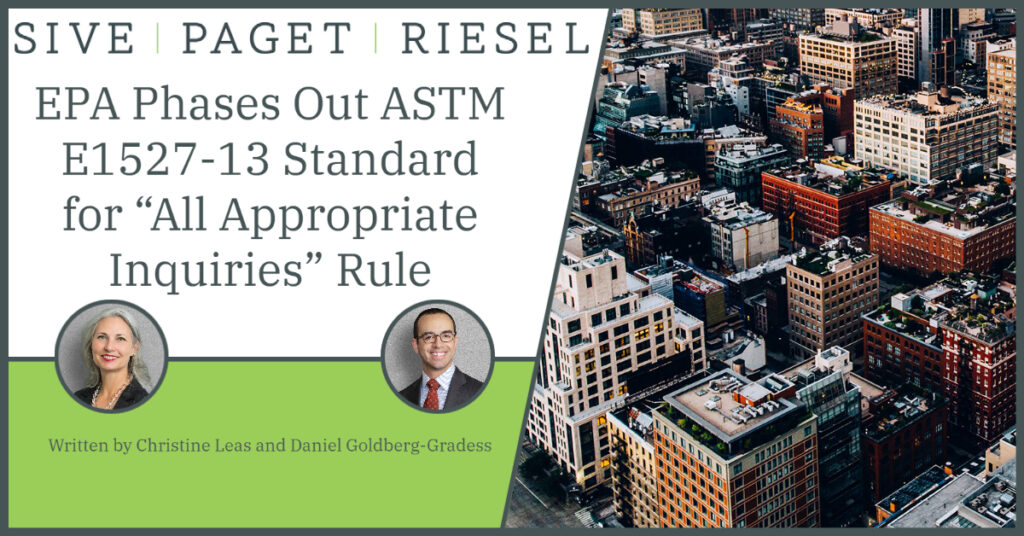Blog

EPA Phases Out ASTM E1527-13 Standard for “All Appropriate Inquiries” Rule
The U.S. Environmental Protection Agency issued a final rule on December 15, 2022, allowing for the use of ASTM International’s E1527-21 standard for Phase I Environmental Site Assessments (ESAs) to satisfy the requirements of the All Appropriate Inquiries Rule (AAI Rule). The final rule will go into effect on February 13, 2023. The notice accompanying the rule provides that after a one-year sunset period, the prior ASTM E1527-13 standard will no longer satisfy the AAI rule.
Under the AAI Rule, purchasers of potentially contaminated properties must conduct “all appropriate inquiries” into a property’s prior use and ownership to qualify for certain defenses to liability under the Comprehensive Environmental Response, Compensation, and Liability Act (CERCLA). To meet these requirements, parties hire environmental professionals to perform Phase I ESAs, which identify environmental conditions on properties with respect to hazardous substances and petroleum products, as well as certain business risks such as lead-based paint.
EPA’s announcement comes in response to comments—only 13 in total—on its prior March 2022 direct final rule (the March rule) amending the AAI Rule to add a reference to ASTM E1527-21 as an appropriate standard for Phase I ESAs. The March rule also recognized that the ASTM E1527-13 standard, which had been in use since 2013, would continue to satisfy the AAI Rule. EPA invited public comments on the proposed change and stated that it would withdraw the March rule if it received adverse comments. After receiving comments from the regulated community, including environmental consultants and other industry actors involved in preparing Phase I ESAs, EPA withdrew the March rule on May 2, 2022.
The public comments expressed concern over the March rule’s potential to cause confusion in the marketplace and lower the quality of ESAs. Several commenters wrote that ASTM E1527-21 should replace, and not supplement, ASTM E1527-13, because ASTM E1527-21 reflects the current industry consensus on best practices for ESAs. The newer standard clarifies, for example, the traditionally murky distinction between Historical Recognized Environmental Conditions (HRECs) and Controlled Recognized Environmental Conditions (CRECs), and refines standards for historical research and site reconnaissance. An in-depth comparison of the -13 and -21 ASTM standards can be found in SPR’s prior blog post.
There is some ambiguity in the text of the final rule, and in the notice accompanying it in the Federal Register, regarding the date on which the -13 standard will stop satisfying the AAI Rule. The Federal Register notice states that “the sunset period for removal of the reference to the ASTM E1527-13 Standard … is one year from publication of this final rule” and “the removal of the reference to the historic standard [ASTM E1527-13] as compliant with the all appropriate inquiries requirements will take effect one year following publication of this final rule” (i.e., on December 15, 2023). But elsewhere, the notice states that “any party who wants to claim protection from liability under one of CERCLA’s landowner liability protections may … use the ASTM E1527-13 [standard] for up to one year after this rule becomes effective” (i.e., until February 13, 2024). EPA’s announcement also revises the text of the AAI Rule (40 CFR Part 312) to include ASTM E1527-13 as a Reference “until February 13, 2024.” It is therefore unclear whether an ESA that uses the -13 standard will satisfy the AAI Rule if it is finalized between the anniversary of the final rule’s publication date and the anniversary of the final rule’s effective date.
This ambiguity is yet another reason for ESA users and preparers to follow the ASTM E1527-21 standard, which is now a best practice used by most prudent purchasers and will soon be accepted by EPA.
EPA’s process for arriving at this final rule can also serve as encouragement for the regulated community and other members of the public to submit substantive, thoughtful comments to the agency, which responded to a relatively modest number of public comments on the March rule by making substantive changes to its final rule.
Finally, EPA’s adoption of the more stringent ASTM E1527-21 standard underscores the critical importance of having knowledgeable and experienced environmental counsel assist in the review of Phase I ESA reports. The identification and characterization of CRECs, HRECs, and de minimis conditions under the new standard can have decisive impacts on the approaches of current and prospective property owners, lenders, and lessees to property acquisitions, conveyances, financing, and leases, as well as eligibility for enrollment in voluntary remedial programs such as the New York State Brownfield Cleanup Program.